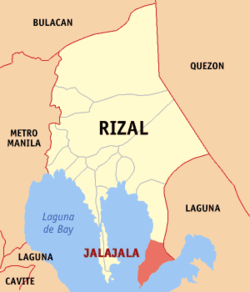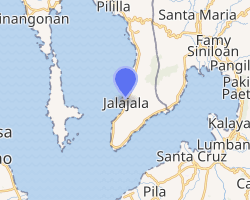Jalajala
Jalajala (Tagalog pronunciation: [hälɐ̞ˈhalɐ]; also spelled as Jala-jala), officially the Municipality of Jalajala (Tagalog: Bayan ng Jalajala), is a 4th class municipality in the province of Rizal, Philippines. According to the 2015 census, it has a population of 32,254 people.[3]
Jalajala | |
|---|---|
| Municipality of Jalajala | |
Aerial view | |
 Seal | |
| Anthem: Himno ng Bayan ng Jalajala | |
 Map of Rizal with Jalajala highlighted | |
OpenStreetMap 
| |
.svg.png) Jalajala Location within the Philippines | |
| Coordinates: 14°21′21″N 121°19′24″E | |
| Country | |
| Region | Calabarzon (Region IV-A) |
| Province | Rizal |
| District | 2nd District |
| Founded | March 27, 1907 |
| Barangays | 11 (see Barangays) |
| Government | |
| • Type | Sangguniang Bayan |
| • Mayor | Elmer C. Pillas |
| • Vice Mayor | Jarry V. Añago |
| • Congressman | Juan Fidel Felipe F. Nograles |
| • Electorate | 21,291 voters (2019) |
| Area | |
| • Total | 44.12 km2 (17.03 sq mi) |
| Population (2015 census)[3] | |
| • Total | 32,254 |
| • Density | 730/km2 (1,900/sq mi) |
| • Households | 6,836 |
| Economy | |
| • Income class | 4th municipal income class |
| • Poverty incidence | 17.66% (2015)[4] |
| • Revenue (₱) | 77,517,427.33 (2016) |
| Time zone | UTC+8 (PST) |
| ZIP code | 1990 |
| PSGC | |
| IDD : area code | +63 (0)2 |
| Climate type | tropical monsoon climate |
| Native languages | Tagalog |
| Website | www |
Etymology
What is now the town's Barangay Punta was the seat of an earlier settlement later known as Halaán. During the summer from April to May, the shores of Laguna de Bay along Punta would be filled with small shellfish locally known as halaán.
As is typical with many modern Philippine toponyms, the town's name supposedly resulted from miscommunication between early Spanish visitors and natives. The Spaniards enquired of some natives along the shoreline, "¿Como se llama este sitio?" ("What is the name of this place?") to which the latter replied, "halaán pò," thinking that the foreigners referred to the shells. The Spaniards accepted the response as the name of the place, and began calling it halaán, later corrupting it into Jalajala.
Another folk etymology is that Jalajala stems from an endemic breed of boar called berk jala, which is abundant in the wilds around the town and is depicted on its seal. As with the other story, a Spaniard asked the Tagalog-speaking natives the place's name, and the locals' interjection of "hala-hala” (possibly a hunting chant) was taken by the Spaniards to be their answer.
Geography
Jalajala is on a peninsula located 75 kilometres (47 mi) southeast of Manila in the largest freshwater lake in the Philippines, Laguna de Bay. It lies on the eastern part of the Rizal Province and has a land area of 4,930.000 hectares representing 3.77% of the total land area of the province. Jalajala’s political boundary on the north is the Panguil River, wherein it shares the boundary with the town of Pakil in Laguna. On its southern, eastern, and western boundaries lies the Laguna de Bay.
Mount Sembrano forms the boundary of Jalajala and Pililla.
Barangays

Jalajala is politically subdivided into eleven barangays (three urban, eight rural). [2] Bayugo, Palay-Palay, and Sipsipin were elevated as barrios in 1956.[5]
Climate
| Climate data for Jalajala, Rizal | |||||||||||||
|---|---|---|---|---|---|---|---|---|---|---|---|---|---|
| Month | Jan | Feb | Mar | Apr | May | Jun | Jul | Aug | Sep | Oct | Nov | Dec | Year |
| Average high °C (°F) | 26 (79) |
27 (81) |
29 (84) |
31 (88) |
31 (88) |
30 (86) |
29 (84) |
29 (84) |
29 (84) |
29 (84) |
28 (82) |
26 (79) |
29 (84) |
| Average low °C (°F) | 22 (72) |
22 (72) |
22 (72) |
23 (73) |
24 (75) |
25 (77) |
24 (75) |
24 (75) |
24 (75) |
24 (75) |
24 (75) |
23 (73) |
23 (74) |
| Average precipitation mm (inches) | 58 (2.3) |
41 (1.6) |
32 (1.3) |
29 (1.1) |
91 (3.6) |
143 (5.6) |
181 (7.1) |
162 (6.4) |
172 (6.8) |
164 (6.5) |
113 (4.4) |
121 (4.8) |
1,307 (51.5) |
| Average rainy days | 13.4 | 9.3 | 9.1 | 9.8 | 19.1 | 22.9 | 26.6 | 24.9 | 25.0 | 21.4 | 16.5 | 16.5 | 214.5 |
| Source: Meteoblue [6] | |||||||||||||
Demographics
| Year | Pop. | ±% p.a. |
|---|---|---|
| 1903 | 1,217 | — |
| 1918 | 1,584 | +1.77% |
| 1939 | 1,532 | −0.16% |
| 1948 | 2,429 | +5.25% |
| 1960 | 5,223 | +6.59% |
| 1970 | 8,115 | +4.50% |
| 1975 | 9,276 | +2.72% |
| 1980 | 11,945 | +5.19% |
| 1990 | 16,318 | +3.17% |
| 1995 | 19,873 | +3.76% |
| 2000 | 23,280 | +3.45% |
| 2007 | 28,738 | +2.95% |
| 2015 | 32,254 | +1.45% |
| Source: Philippine Statistics Authority[3][7][8][9] | ||
In the 2015 census, the population of Jala-jala, was 32,254 people,[3] with a density of 730 inhabitants per square kilometre or 1,900 inhabitants per square mile.
References
- "Municipality". Quezon City, Philippines: Department of the Interior and Local Government. Retrieved 31 May 2013.
- "Province: Rizal". PSGC Interactive. Quezon City, Philippines: Philippine Statistics Authority. Retrieved 12 November 2016.
- Census of Population (2015). "Region IV-A (Calabarzon)". Total Population by Province, City, Municipality and Barangay. PSA. Retrieved 20 June 2016.
- "PSA releases the 2015 Municipal and City Level Poverty Estimates". Quezon City, Philippines. Retrieved 1 January 2020.
- "An Act Converting the Sitios of Bayugo, Palay-palay, and Sipsipin, Municipality of Jalajala, Province of Rizal, into Barrios of Said Municipality". LawPH.com. Retrieved 2011-04-12.
- "Jalajala: Average Temperatures and Rainfall". Meteoblue. Retrieved 11 May 2020.
- Census of Population and Housing (2010). "Region IV-A (Calabarzon)". Total Population by Province, City, Municipality and Barangay. NSO. Retrieved 29 June 2016.
- Censuses of Population (1903–2007). "Region IV-A (Calabarzon)". Table 1. Population Enumerated in Various Censuses by Province/Highly Urbanized City: 1903 to 2007. NSO.
- "Province of Rizal". Municipality Population Data. Local Water Utilities Administration Research Division. Retrieved 17 December 2016.
External links
| Wikimedia Commons has media related to Jalajala, Rizal. |